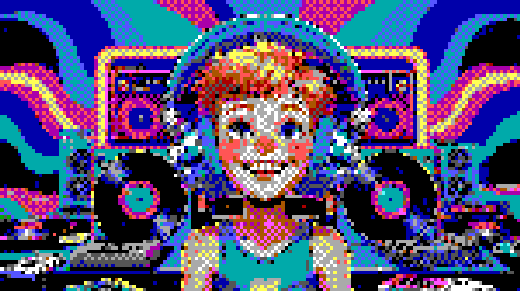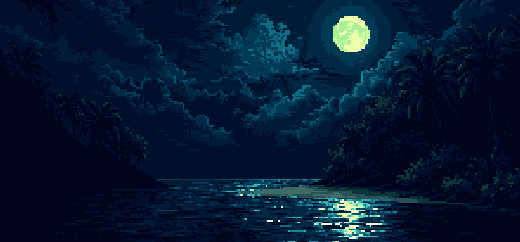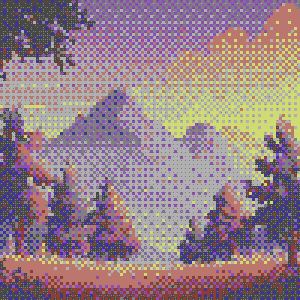Dithering Through Time: How 80s Limitations Created Timeless Beauty
It was the early 80s, and the gaming world was barely a whisper of what we know today. Back then, computers weren’t the sleek, omnipotent machines we carry in our pockets now. They were hefty boxes with beige tones, screaming for attention through flickering CRT screens. Graphics? Let’s just say "blocky" was an understatement. But this was where the magic began—a time when artists and programmers turned the very concept of limitation into a breeding ground for creativity.
The Birth of Pixels and Dithering
If you’ve ever stared at an old video game and wondered why the shading looks like a checkerboard on steroids, congratulations! You’ve met dithering. Dithering was a trick—a genius hack, really—used to blend colors that didn’t exist on the palette by alternating pixels of two different shades. It’s a little like mixing paint, except instead of brushes and colors, you had a grand total of 16 hues on a Commodore 64.
The C64 was the darling of the 80s gaming world, a machine with 64 kilobytes of RAM (yes, kilobytes). It had a resolution of 320x200 pixels and supported just 16 colors—each one more garish than the last. Yet, with this pitiful toolbox, artists conjured up intricate landscapes, spaceships, and even lifelike characters. They used dithering to create the illusion of more depth, gradients, and textures than the system could handle. The result? Art that tricked your eyes into seeing more than was really there.
 150x84px CGA-16-Color rendering with Bayer-Matrix 8x8 Dithering
150x84px CGA-16-Color rendering with Bayer-Matrix 8x8 Dithering
This wasn’t just about making something “look pretty.” It was economic ingenuity. You had to think small—literally. Every byte counted. Every pixel had to pull double or triple duty. And it wasn’t just the artists doing mental gymnastics. Programmers were shaving bits off code like a carpenter sanding down wood.
Games with No Graphics (Well, Almost)
The earliest games didn’t even bother pretending to have stunning visuals. Take Adventure (1980), where you were represented by a square and enemies were other shapes. That was it. And yet, people were hooked. The imagination filled in the gaps.
By the mid-80s, graphical prowess started to bloom. Games like The Last Ninja and Impossible Mission showcased what the C64 could do in the hands of virtuosos. Dithering wasn’t just a necessity—it was a style. It was art. Limited colors became a signature look that’s still celebrated today in pixel art.
From Blocky Brilliance to Beige Overload:
The Rise and Fall of Gaming Graphics
By the late ’80s, gaming took a quantum leap forward with machines like the Amiga, which flexed its hardware muscle with advanced sound and graphics. Suddenly, games weren’t just functional—they were cinematic. Titles like Shadow of the Beast dazzled with parallax scrolling, vibrant color palettes, and soundtracks that could make your jaw drop. Then came the PC’s rise to power in the early ‘90s, riding on the coattails of VGA graphics cards and the advent of 640x480 resolution—a massive leap for anyone accustomed to the blocky 8-bit look. Games like Monkey Island were no longer just visually engaging but also showcased the magic of MIDI soundtracks, amplified by the AdLib and Sound Blaster cards. Who could forget Guybrush Threepwood’s pixel-perfect smirk paired with that glorious steel-drum theme?
 520x242px, 23 color custom palette, no dithering
520x242px, 23 color custom palette, no dithering
But as we reached 1024x768 resolution and true color (16 million colors!), things went a bit… wahoney. Sure, it was technically impressive to see gradients so smooth you’d want to touch them, but did anyone really ask for ultra-crisp textures in games like Myst when we could’ve had more memorable pixel art? Sometimes, more isn’t better—sometimes, it’s just a lot of beige wallpaper, you know? But hey, at least the soundtracks kept improving – sort of ...
From Ingenuity to Excess
Fast forward to now. We’ve got VR that can drop you into lifelike worlds, AI that paints in styles no human could dream of, and games with more polygons in one character model than an entire 80s arcade lineup combined. But something’s missing.
With all this horsepower, it feels like the soul of creativity has dulled in places. Back then, you needed to fight the system, wrestle beauty out of brutal limitations. Now, you can throw computing power at a problem until it looks polished. You can let an algorithm “paint” your vision for you. It’s impressive—but is it clever?
The real irony? With infinite resources, we’ve lost the urgency that birthed so much genius. The simplicity and directness of the old days forced people to create worlds from dust. Today, some of those same principles—economy, constraint, and ingenuity—are what give pixel art, lo-fi music, and retro games their timeless appeal.
Embrace the Tools, but Don’t Forget the Woods
Here’s the thing: The digital world is overwhelming, sure. It’s easy to get lost in endless options, algorithms, and features. But when you know what you’re doing, when you apply the lessons of those who worked with almost nothing, the possibilities are endless.
Learn from the pioneers who turned 16 colors into masterpieces and kB into kingdoms. Use today’s tech wisely, but don’t let it use you. And if it ever gets to be too much, if the pixels blur together and the digital world weighs heavy, step IRL.
Walk in the woods. Feel the analog dirt under your boots, watch sunlight filter through the leaves.
